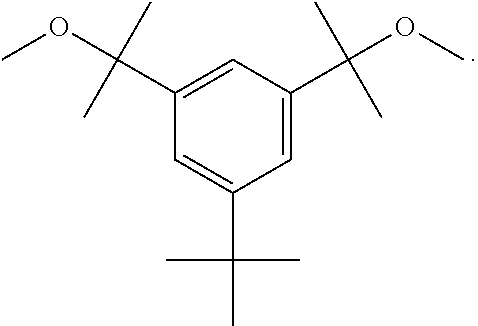Synthetic methods pertaining to tert-butyl-benzene-based compounds
a technology of tert-butyl benzene and benzene, which is applied in the direction of ether preparation, organic chemistry, chemistry apparatus and processes, etc., can solve the problems of limited use of cationally polymerized telechelic, difunctional polyisobutylene soft segments, including telechelic,
- Summary
- Abstract
- Description
- Claims
- Application Information
AI Technical Summary
Benefits of technology
Problems solved by technology
Method used
Image
Examples
example 1
Dimethyl 5-tert-butylisophthalate Prepared Using Molecular Sieves
[0035]5-tert-Butylisophthalic acid (25.0 grams, 0.112 moles) was placed in a 500-mL, three-neck, round-bottomed flask along with a magnetic stir bar. The necks of the flask were fitted with a thermocouple, a septum and the body of a Soxhlet extractor. A flow of dry nitrogen was introduced to the flask via a needle that pierced the septum. 30 grams of 3 A molecular sieves, which had been dried overnight at 150° C. under a nitrogen atmosphere, were loaded into a 25 mm×90 mm extraction thimble. The thimble was inserted into the extractor body and a condenser was placed atop the body. A nitrogen outlet, connected to a bubbler, was attached to the top of the condenser.
[0036]Anhydrous methanol (125 mL, 99 grams, 3.00 moles; a 27-fold molar excess versus 5-tert-butylisophthalic acid) was added via cannula to the round-bottom flask. Sulfuric acid catalyst (96-98%; 3.75 mL, 6.9 grams) was added next. The mixture was heated to r...
example 2
Preparation of 5-tert-butyl-1,3-bis(1-methoxy-1-methylethyl)benzene (HDCE) Via Etherification with Methanol in the Presence of a Superbase
[0041]All glassware used in this example was oven-dried overnight and assembled hot and / or under a stream of dry nitrogen. The starting material, 5-tert-butyl-1,3-bis(1-hydroxy-1-methylethyl)benzene (HDCA) may be formed by the Grignard reaction of dimethyl 5-tert-butylisophthalate (see Example 1) with methylmagnesium bromide to produce HDCA, as is known in the art. See B. Wang et al., Polymer Bulletin (Berlin, Germany), 1987, 17, 205-21.
[0042]In a 500-mL boiling flask, HDCA (10.0 g, 0.0399 moles), was dissolved in 200 mL anhydrous THF. The THF solution was transferred via cannula to a 250-mL pressure-equalizing addition funnel. The funnel and a nitrogen inlet were fitted to a Claisen adapter and the adapter placed on one neck of a 500-mL, three-necked, round-bottom flask. A thermocouple and a nitrogen outlet, connected to a bubbler, were inserted ...
PUM
| Property | Measurement | Unit |
|---|---|---|
| temperature | aaaaa | aaaaa |
| temperature | aaaaa | aaaaa |
| pKa | aaaaa | aaaaa |
Abstract
Description
Claims
Application Information
 Login to View More
Login to View More - R&D
- Intellectual Property
- Life Sciences
- Materials
- Tech Scout
- Unparalleled Data Quality
- Higher Quality Content
- 60% Fewer Hallucinations
Browse by: Latest US Patents, China's latest patents, Technical Efficacy Thesaurus, Application Domain, Technology Topic, Popular Technical Reports.
© 2025 PatSnap. All rights reserved.Legal|Privacy policy|Modern Slavery Act Transparency Statement|Sitemap|About US| Contact US: help@patsnap.com



